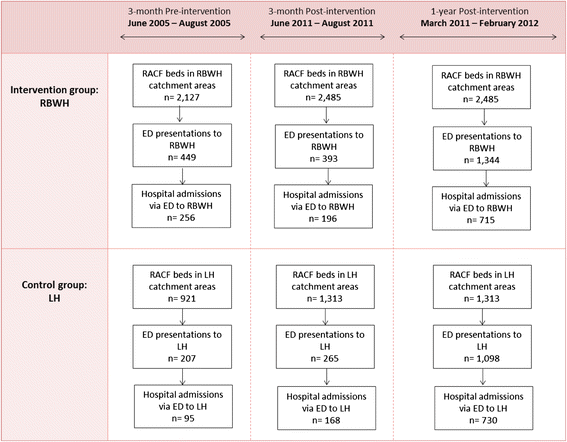Hospital in the Nursing Home program reduces emergency department presentations and hospital admissions from residential aged care facilities in Queensland, Australia: a quasi-experimental study
- PMID: 26857447
- PMCID: PMC4746777
- DOI: 10.1186/s12913-016-1275-z
Hospital in the Nursing Home program reduces emergency department presentations and hospital admissions from residential aged care facilities in Queensland, Australia: a quasi-experimental study
Abstract
Background: There has been considerable publicity regarding population ageing and hospital emergency department (ED) overcrowding. Our study aims to investigate impact of one intervention piloted in Queensland Australia, the Hospital in the Nursing Home (HiNH) program, on reducing ED and hospital attendances from residential aged care facilities (RACFs).
Methods: A quasi-experimental study was conducted at an intervention hospital undertaking the program and a control hospital with normal practice. Routine Queensland health information system data were extracted for analysis.
Results: Significant reductions in the number of ED presentations per 1000 RACF beds (rate ratio (95 % CI): 0.78 (0.67-0.92); p = 0.002), number of hospital admissions per 1000 RACF beds (0.62 (0.50-0.76); p < 0.0001), and number of hospital admissions per 100 ED presentations (0.61 (0.43-0.85); p = 0.004) were noticed in the experimental hospital after the intervention; while there were no significant differences between intervention and control hospitals before the intervention. Pre-test and post-test comparison in the intervention hospital also presented significant decreases in ED presentation rate (0.75 (0.65-0.86); p < 0.0001) and hospital admission rate per RACF bed (0.66 (0.54-0.79); p < 0.0001), and a non-significant reduction in hospital admission rate per ED presentation (0.82 (0.61-1.11); p = 0.196).
Conclusions: Hospital in the Nursing Home program could be effective in reducing ED presentations and hospital admissions from RACF residents. Implementation of the program across a variety of settings is preferred to fully assess the ongoing benefits for patients and any possible cost-savings.
Figures
Similar articles
-
Emergency department transfers and hospital admissions from residential aged care facilities: a controlled pre-post design study.BMC Geriatr. 2016 May 12;16:102. doi: 10.1186/s12877-016-0279-1. BMC Geriatr. 2016. PMID: 27175921 Free PMC article. Clinical Trial.
-
Cost analysis of improving emergency care for aged care residents under a Hospital in the Nursing Home program in Australia.PLoS One. 2018 Jul 3;13(7):e0199879. doi: 10.1371/journal.pone.0199879. eCollection 2018. PLoS One. 2018. PMID: 29969468 Free PMC article.
-
Effect of the Geriatric Emergency Department Intervention on outcomes of care for residents of aged care facilities: A non-randomised trial.Emerg Med Australas. 2020 Jun;32(3):422-429. doi: 10.1111/1742-6723.13415. Epub 2019 Nov 26. Emerg Med Australas. 2020. PMID: 31773885 Clinical Trial.
-
What is the evidence for the management of patients along the pathway from the emergency department to acute admission to reduce unplanned attendance and admission? An evidence synthesis.BMC Health Serv Res. 2017 May 16;17(1):355. doi: 10.1186/s12913-017-2299-8. BMC Health Serv Res. 2017. PMID: 28511702 Free PMC article. Review.
-
Unplanned Transfer to Emergency Departments for Frail Elderly Residents of Aged Care Facilities: A Review of Patient and Organizational Factors.J Am Med Dir Assoc. 2015 Jul 1;16(7):551-62. doi: 10.1016/j.jamda.2015.03.007. Epub 2015 Apr 28. J Am Med Dir Assoc. 2015. PMID: 25933726 Review.
Cited by
-
Factors impacting hospital avoidance program utilisation in the care of acutely unwell residential aged care facility residents.BMC Health Serv Res. 2021 Jun 24;21(1):599. doi: 10.1186/s12913-021-06575-1. BMC Health Serv Res. 2021. PMID: 34162385 Free PMC article.
-
The development and validation of a conceptual definition of avoidable transitions from long-term care to the emergency department: A mixed methods study.Health Sci Rep. 2024 Jul 4;7(7):e2204. doi: 10.1002/hsr2.2204. eCollection 2024 Jul. Health Sci Rep. 2024. PMID: 38974331 Free PMC article.
-
Understanding the Clinical Profile and Hospitalisation Patterns of Residents From Aged Care Facilities: A Regional Victorian Hospital Study.Cureus. 2023 Jul 30;15(7):e42694. doi: 10.7759/cureus.42694. eCollection 2023 Jul. Cureus. 2023. PMID: 37649940 Free PMC article.
-
Low Back Pain Presentation and Management at the Emergency Department: Differences Between Older Adults Residing in the Community and Aged Care Homes.J Eval Clin Pract. 2025 Apr;31(3):e70088. doi: 10.1111/jep.70088. J Eval Clin Pract. 2025. PMID: 40214149 Free PMC article.
-
The Geriatric Emergency Department Intervention model of care: a pragmatic trial.BMC Geriatr. 2018 Dec 3;18(1):297. doi: 10.1186/s12877-018-0992-z. BMC Geriatr. 2018. PMID: 30509204 Free PMC article. Clinical Trial.
References
-
- Australian Institute of Health and Welfare . Residential aged care in Australia 2010-11: a statistical overview. Canberra: AIHW; 2012.
-
- Arendts G, Etherton-Beer C, Howard K, Lewin G, Sim M, Pickstock S, et al. Nurse led care coordination: trial protocol and development of a best practice resource guide for a cluster controlled clinical trial in Australian aged care facilities. Arch Gerontol Geriatr. 2014;58(1):15–9. doi: 10.1016/j.archger.2013.07.004. - DOI - PubMed
Publication types
MeSH terms
LinkOut - more resources
Full Text Sources
Other Literature Sources
Medical


